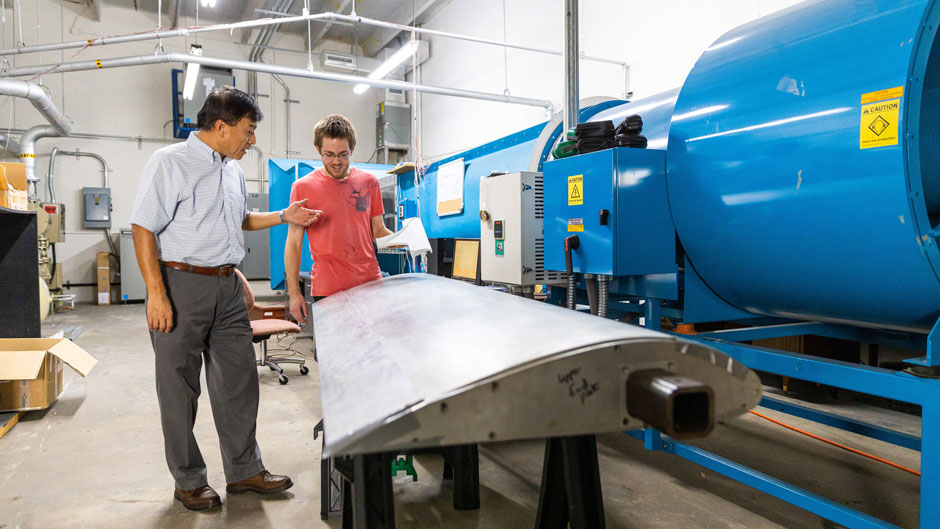It takes University of Miami researcher GeCheng Zha about 45 minutes to drive from his Cutler Bay home to work. And that’s on a good day, when traffic along Old Cutler Road, his preferred route to campus, is flowing freely.
But imagine Zha’s 14-mile commute to and from the UM campus taking no more than ten minutes, even when a motor vehicle accident or road construction snarls traffic.
A new aircraft wing and airfoil developed by Zha could help make such a speedy commute possible, ushering in an era of urban air transportation in which electric-powered vertical-takeoff planes operate high above heavily congested cities, shuttling people to work, school and other destinations and delivering everything from food to medicine while at the same time reducing greenhouse gas emissions.
“Look at some of the biggest cities in the U.S.; they’re all facing challenges to their ground transportation networks because of increasing traffic,” said Zha, a professor of aerospace engineering and director of the Aerodynamics and Computational Fluid Dynamics Lab at the College of Engineering. “It is important that we develop green aviation for the future because our highway infrastructure just won’t be able to keep pace with population growth.”
Vertical and/or short takeoff and landing (V/STOL) aircraft have existed for decades, going back to the days of the earliest helicopters. But many employ a tiltrotor system to achieve lift and propulsion, utilizing enormous power and generating excessive noise in the process.
An electric V/STOL system developed by Zha minimizes power consumption and noise by generating lift from the wings instead of from the propellers or rotors only. It is called co-flow jet (CFJ) airfoil technology, and a series of micro-compressors embedded into the airfoil of the wing is the key to its success, according to Zha.
Those micro-compressors suck in, pressurize and then expel air to achieve lift, and also work in tandem with a distributed propulsion system to create thrust.
Zha actually developed CFJ technology in 2003 while working at the Dayton, Ohio-based Wright-Patterson Air Force Base on a summer research project to improve the efficiency of jet engines. With funding from the Defense Advanced Research Projects Agency, NASA and others, he spent the next 15 years at UM applying the technology to an aircraft wing, developing and building a prototype airfoil that has been tested in a subsonic wind tunnel at Texas A&M University and at a UM-operated wind tunnel facility in Miami’s Bird Road industrial district.
Test results have been astonishing, with data showing the new wing and its airfoil achieving a maximum lift coefficient that exceeds the theoretical limit of classical aerodynamics. “The co-flow airfoil can also have cruise efficiency significantly greater than the conventional one when the flow is benign,” said Zha.
He believes the technology can help change the aviation industry, leading to greater use of electricity to power planes. “We need to develop low-emission green aviation to combat global warming,” he said.
Greenhouse gas emissions from commercial aviation are rising. In fact, the United Nations’ International Civil Aviation Organization expects aviation emissions to roughly triple by 2050, at which time aircraft might account for 25 percent of the global carbon budget.
More research on his co-flow jet technology needs to be conducted, and that’s where a proposed new center backed by the National Science Foundation (NSF) comes into play.
Zha is spearheading an NSF planning grant to establish a multi-institutional Engineering Research Center for Green Air Transportation where engineers would conduct aerodynamic, structural, acoustic, and thermodynamic research and testing of CFJ-V/STOL technology, with the ultimate goal being a flight demonstration of a prototype electric V/STOL aircraft.
Assessing the economic viability of and estimating the market demand for electric-powered vertical-takeoff aircraft could be an additional goal of the center, which would be based elsewhere.
Such aircraft, explained Joseph Johnson, an associate professor of marketing at the Miami Herbert Business School who specializes in marketing analytics and new product development, could reduce the operational costs for e-commerce and shipping companies by as much as 30 percent. “It will increase the utilization of secondary and tertiary airports,” said Johnson. For commuter markets, he added, “it will help in reducing commute times and increase travel flexibility without incurring expensive infrastructure like roads.”
But the green aviation market is not without its challenges, as regulatory clearances, infrastructural development like charging stations for batteries at smaller airports, and private investment are just some of the barriers to success, said Johnson.
Outreach and education are needed to inform students and the public about the benefits of green aviation, said Jennifer Kahn, an assistant professor of teaching and learning in the School of Education and Human Development, who said partnerships with museums and educational programs like field trips could achieve that goal.
For now, Zha will have to continue his daily commute to work via automobile. But he envisions air taxis, people owning their own vertical takeoff and landing aircraft and using them to travel to work or to South Beach for a night on the town, first responders and humanitarian aid workers using such aircraft to access hard to reach places, and regional airlines using V/STOL aircraft for short flights carrying up to 15 passengers.
“It’s definitely the future of flight,” he said.

